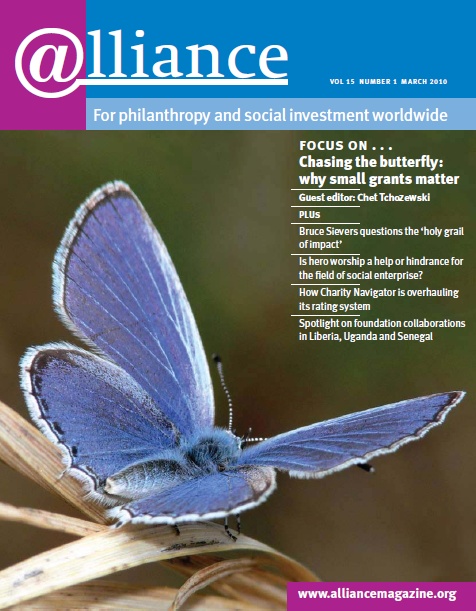Last autumn, the enormously popular American microfinance website Kiva began receiving the worst kind of attention. The site, which allows small donors to make interest-free loans via microfinance institutions in dozens of countries, was taken to task for giving users the impression that they were making loans to specific borrowers. In fact, the borrowers had already received loans, and Kiva’s users were lending money to microfinance institutions, not specific individuals.
 As I write, the disaster relief effort in Haiti is being aided by the rapid deployment of a service called Ushahidi which allows individuals to share crisis information via SMS. Originally developed to map reports of violence in post-election Kenya in 2008, the service pulls together geographic information from a user’s phone with the text of their SMS to create a real-time map of information that can be used for crisis management.
As I write, the disaster relief effort in Haiti is being aided by the rapid deployment of a service called Ushahidi which allows individuals to share crisis information via SMS. Originally developed to map reports of violence in post-election Kenya in 2008, the service pulls together geographic information from a user’s phone with the text of their SMS to create a real-time map of information that can be used for crisis management.
Kiva and Ushahidi are both harbingers of the introduction of person-to-person (or P2P) technology into philanthropy – a massive change that neither funders nor NGOs have begun to grapple with.
The huge success of Kiva – it has arranged $100 million in microfinance funding, mostly via $20 transactions, in just four years – was driven by its delivery of the appearance of P2P connections. As a Kiva member, I could choose who to loan money to and become connected quite intimately with a specific person’s efforts to improve their life. At least that was the illusion – and such illusions are very compelling to donors. They are at the heart of the child sponsorship and alternative gift (‘buy a goat’) models of charity. We love to feel we are making a specific difference in a specific person’s life. Kiva succeeded by making the illusion even more compelling by adding detail, detail enabled by technology.
Of course, anyone with a passing knowledge of child sponsorship knows that the system doesn’t work the way it is marketed to donors. The same was true of Kiva – and in both cases for good reason. If the systems are to work to the maximum benefit of the recipient, there cannot be a direct connection between donor and recipient. Recipients need consistency and certainty on timelines not dictated by faraway donors.
But the P2P connection is happening anyway, as Ushahidi shows. Minute by minute, you can see on-the-ground reports and pleas for help from Haiti. Any donor, large or small, can be connected to real-time information direct from people in need. The penetration of cellular technology throughout the developing world (which now accounts for 60 per cent of global cellphone usage) means that this phenomenon will grow, and grow rapidly.
Many commentators are hailing these P2P connections as a dramatic new force for accountability. GlobalGiving – a site similar to Kiva – used SMS messaging to allow recipients to report on a project it funded last year, and found that the director of the programme was abusing his power.
While the accountability benefits of P2P are real, there are major downsides that have yet to be reckoned with. The most important part of the Kiva controversy was the expectation of donors that they would truly have a P2P connection to borrowers. Models built on the illusion of direct connection (some experts estimate that child sponsorship is the single largest driver of international giving in the US and UK) are going to come under extreme pressure as donors begin to ask not for an annual letter from a sponsored child but for his or her cellphone number. What is the role of the NGO when their donors can easily and cheaply connect directly to people in need? Will donors learn to appreciate the value of on-the-ground knowledge and sector expertise? How will NGOs serve the needs of both recipients and donors when the illusion of P2P is replaced by reality?
Foundations face equally momentous questions. Those that have been dealing with the challenges of power dynamics in their relationships with NGOs will have to begin thinking about power dynamics between themselves and local recipients who are texting foundation staff. How will programme staff struggling to manage a flood of funding requests from NGOs all over the world deal with a hundredfold increase in communication from people on the ground? How will foundations that have struggled to bring feedback from and accountability to NGOs into their strategy, planning and operations deal with feedback and being held accountable by recipients?
The P2P revolution in philanthropy isn’t coming. Kiva and Ushahidi show us it has already arrived. And it’s time to start asking questions about how we will respond.
Tim Ogden is co-founder and editor-in-chief of Philanthropy Action. Email timothy.ogden@philanthropyaction.com






Comments (0)